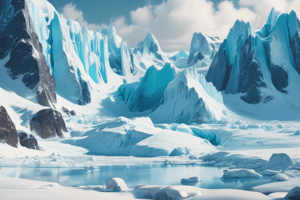Podcast
Questions and Answers
What percentage of the Earth's land surface is covered by glaciers?
What percentage of the Earth's land surface is covered by glaciers?
- 50%
- 25%
- 10% (correct)
- 75%
What is the largest reservoir of freshwater on Earth?
What is the largest reservoir of freshwater on Earth?
- Lakes
- Groundwater
- Glacial ice (correct)
- Rivers
What is the main cause of glacial displacement?
What is the main cause of glacial displacement?
- Sunlight
- Rain
- Wind
- Gravity (correct)
What are crevasses, bergschrunds, seracs, and moulins?
What are crevasses, bergschrunds, seracs, and moulins?
What is the health of a glacier usually assessed by?
What is the health of a glacier usually assessed by?
What are ogives or Forbes bands?
What are ogives or Forbes bands?
What is a drumlin?
What is a drumlin?
What is the process by which glaciers erode terrain?
What is the process by which glaciers erode terrain?
What is causing current global warming?
What is causing current global warming?
Flashcards
Glaciers
Glaciers
Dense ice bodies moving under their own weight, formed where snow accumulation exceeds ablation over years.
Glacier Formation
Glacier Formation
The process where snow accumulation surpasses melting over an extended period, leading to glacier formation.
Glacier Coverage
Glacier Coverage
Glaciers cover about 10% of Earth's land. They hold 69% of the world's freshwater.
Glacial Erosion
Glacial Erosion
Signup and view all the flashcards
Glacial Moraines
Glacial Moraines
Signup and view all the flashcards
Drumlins
Drumlins
Signup and view all the flashcards
Valley Shape Change
Valley Shape Change
Signup and view all the flashcards
Hanging Valleys
Hanging Valleys
Signup and view all the flashcards
Impacts of Melting Glaciers
Impacts of Melting Glaciers
Signup and view all the flashcards
Study Notes
Glaciers are dense bodies of ice that move under their own weight and are formed where snow accumulation exceeds ablation over many years. Glaciers cover about 10% of the Earth's land surface, and 99% of glacial ice is contained within vast ice sheets in the polar regions. Glacial ice is the largest reservoir of freshwater on Earth, holding about 69% of the world's freshwater, and is an important source of freshwater for plants, animals, and human use. Glaciers are sensitive indicators of climate change and are a major source of variations in sea level. Glaciers are categorized by their morphology, thermal characteristics, and behavior, and can be classified by size, shape, and behavior. Glaciers move downhill by the force of gravity and internal deformation of ice, and the speed of glacial displacement is partly determined by friction. Crevasses, bergschrunds, seracs, and moulins are all features of glaciers. The health of a glacier is usually assessed by determining the glacier mass balance or observing terminus behavior, and healthy glaciers have large accumulation zones, vigorous terminus flow, and more than 60% of their area is snow-covered at the end of the melt season.Facts about Glaciers
-
Glaciers are large masses of ice that form when snow remains in one location long enough to transform into ice.
-
Glaciers cover approximately 10% of the Earth's land surface.
-
Glaciers can move at a rate of several feet per day, and they can cause large scale earthquakes called glacial earthquakes.
-
Ogives or Forbes bands are dark and light bands of ice on glacier surfaces and are linked to seasonal motion of glaciers.
-
Glaciers are present on every continent and in approximately fifty countries.
-
Glaciers erode terrain through two principal processes: plucking and abrasion.
-
Glacial moraines are formed by the deposition of material from a glacier and are exposed after the glacier has retreated.
-
Drumlins are asymmetrical, canoe-shaped hills made mainly of till.
-
Before glaciation, mountain valleys have a characteristic "V" shape, produced by eroding water. During glaciation, these valleys are often widened, deepened and smoothed to form a "U"-shaped glacial valley or glacial trough.
-
Glaciers deepen their valleys more than their smaller tributaries. Therefore, when glaciers recede, the valleys of the tributary glaciers remain above the main glacier's depression and are called hanging valleys.
-
Glaciers, which can be hundreds of thousands of years old, are used to track climate change over long periods of time.
-
Human activities in the industrial era have increased the concentration of carbon dioxide and other heat-trapping greenhouse gases in the air, causing current global warming.Glaciers and their impacts on the environment
-
Global sea levels are rising due to melting glaciers and ice sheets.
-
The impacts of rising sea levels include encroachment on coastal settlements and infrastructure, increased populations in flood zones, existential threats to small islands and low-lying coasts, declines in coastal fishery resources, losses of coastal ecosystems and ecosystem services, groundwater salinization, increased risks to coastal food and water security, and compounding damage from tropical cyclones, flooding, storm surge, and land subsidence.
-
Isostatic rebound occurs when large masses, such as ice sheets or glaciers, depress the Earth's crust into the mantle. After the ice melts, the mantle pushes the crust back up, causing a post-glacial rebound.
-
Dilation-faulting is a geomorphological feature created by the same process on a smaller scale.
-
The polar ice caps of Mars show geologic evidence of glacial deposits.
-
Martian glaciers are affected by the thin Martian atmosphere, leading to ablation caused by sublimation, not melting.
-
Many glaciers on Mars are covered with a layer of rocks that insulate the ice.
-
A radar instrument on board the Mars Reconnaissance Orbiter found ice under a thin layer of rocks in formations called lobate debris aprons (LDAs).
Studying That Suits You
Use AI to generate personalized quizzes and flashcards to suit your learning preferences.




